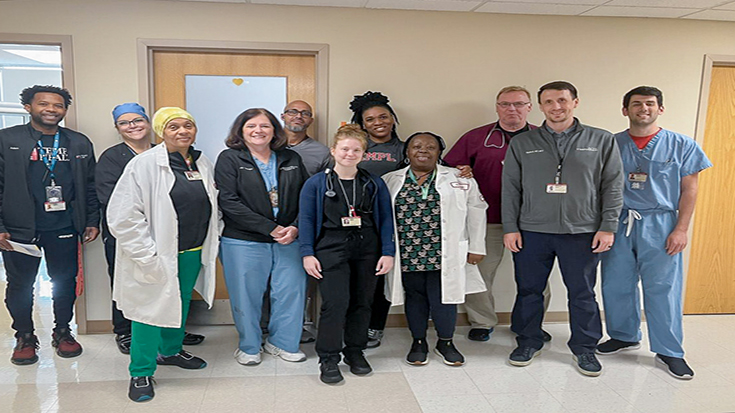
July 13, 2023
Respiratory diagnostics is a key role played by RTs in hospitals across the country, and like other areas of care, it is subject to innovation. At Temple University Hospital in Philadelphia, PA, respiratory therapists on the diagnostics team have recently embarked on two initiatives aimed at ensuring patients at their hospital are receiving state-of-the-art care.
In this interview, Hernan Alvarado, Jr., MBA, RRT, RPFT, associate vice president of respiratory care, bronchoscopy, and pulmonary and sleep diagnostics services, joins his colleagues, Patricia A. Evans, BS, RRT, CPFT, manager of pulmonary function testing, pulmonary rehabilitation, and bronchoscopy, and Stephen Biehl, BS, RRT, RPFT, supervisor of pulmonary function testing and pulmonary rehabilitation, in explaining the new developments.
A couple of years ago, we did an article on your disposable bronchoscope project, in which RTs had a hand in developing a bedside bronchoscopy program that ensured that providers had the correct reusable or disposable scope available. Now you are involved in a program that is bringing bronchoscopy into the operating room. How did you get involved in this new initiative?
Hernan Alvarado: Our institution made a large capital investment in standardizing our practices and location of services for our patients. Respiratory therapists are part of a larger team that is unique, being the only integrated pulmonary, critical care, sleep, and thoracic surgery department in the area. RTs are vital to the management of patients across multiple service lines. We are leaders in this field and this was an opportunity for us to show it.
I understand you will now have bronchoscopy available in three operating rooms. What went into the move and how does having this service available right in the OR benefit patients?
Patricia Evans: The planning for this project and move to the OR has been a long journey. Unfortunately, COVID created a halt to the planning and progress, but eventually the project completion came to full fruition. The operational flow will now have our patients received directly through the short procedure unit versus having to go to our pre-admissions department, thereby avoiding a long travel distance to the current bronchoscopy suite.
The patients will also be recovered in the PACU area post-procedure, which is a much larger area than the prep/hold area in our current suite. In addition, the new suite’s largest procedure room is equipped with an advanced technology cone-beam CT system and an adjacent control room.
What roles have RTs played in the project and how many of your staff have been involved?
Patricia Evans: There are two full-time and one part-time senior respiratory therapists involved in this effort. These three individuals are highly skilled in all aspects of interventional bronchoscopy. This includes everything from basic interventions to advanced interventional cases, such as navigational, EBUS, stents, and bronchial valves for lung volume reduction cases.
The bronchoscopy team has had input throughout the planning of the project on topics ranging from procedure room stock locations to increased expansion needs of the bronchoscopic equipment inventory, inclusive of several new scopes.
About how often will bronchoscopies be performed in the OR, and what role will the RT play on the bronchoscopy team during the procedure?
Patricia Evans: The RTs presently assist with all OR navigational, EBUS, and bronchial lung volume reduction cases that require the OR’s cone beam CT. The current bronchoscopy suite does not have cone beam CT support, so these OR case slots are limited presently. However, as previously mentioned, the new OR bronchoscopy suite will have a new cone beam CT system and will be able to accommodate these cases any day of the week.
On another diagnostic front, you have now embraced the Global Lung Initiative’s race neutral approach for the interpretation of lung function measurements. Tell us more about how RTs were involved in that move and why your hospital felt it was important to do it.
Stephen Biehl: We are very excited to have moved to race neutrality for our PFTs. Our respiratory care leadership team was the driving force leading our medical director, Dr. Gilbert D’Alonzo, to push our health system to embrace this change. We strive to practice the most up-to-date ATS/ERS standards, and this is one that we felt needed to be implemented sooner rather than later for the benefit of our patient population.
What did it take to gain acceptance for this approach in your hospital and how were RTs involved in the educational effort that was needed?
Stephen Biehl: We work with a medical director who is very proactive and quickly supported our move to race neutrality. We had several long discussions about the possible impacts and benefits of this change, with all aspects being weighed carefully, but it was agreed that this would be the best option for our patients.
Our RTs really push the acceptance with other hospital staff and patients when they are asked why there is a difference in their percent predicted spirometry measurements. Our staff and reports remind our physicians to pay attention to the actual numbers when assessing lung function changes over time.
How do you think using the GLI race neutral approach will benefit your patients going forward?
Stephen Biehl: As we follow the most current research in the field of respiratory care, evidence has shown that this change should eliminate race specific algorithms. Race tends to be a social construct and can lead to a variety of negative effects, as well as not being a fixed characteristic. We agreed that PFT interpretation should be based on biological characteristics and not appearance.
What advice do you have for other RT departments that might be interested in getting more involved in innovative projects such as the ones you have talked about here?
Hernan Alvarado: Quality, safety, and standardization are goals that should lead us forward. As respiratory therapists, we are trained to intervene on the patient’s behalf and to be an expert who weighs in on new devices and modalities involved in all aspects of respiratory therapy.
Our integration with pulmonary, critical care, emergency medicine, thoracic surgery, and other service lines is key to collaborating as a team. The bronch initiative is something that could not be accomplished without senior leadership, physician guidance, marketing, operations, regulatory, project management, and so many more individuals.
As RTs, we need to be open to change and evolution. Post pandemic, this is a lesson that we learned and it continues to drives us forward.






